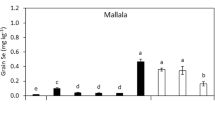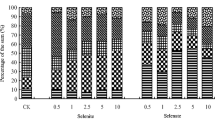Abstract
In areas where soils supply inadequate Se to crops to meet animal nutritional needs, it may be necessary to supplement Se in some fashion. This greenhouse experiment was designed to study the effect of selenate and selenite, incorporated with a Cl- or a SO4-based NPK (16-5-12) fertilizer added to a low-Se soil, on the Se concentration in wheat (Triticum aestivum L.). The sandy soil was limed to pH 5.5 and 6.5 prior to receiving 0, 0.03, or 0.06 mg Se kg−1 of soil with each NPK source each year for two years. The SO4-based NPK fertilizer treatment was used only at the 0.06 mg Se kg−1 rate. In the third year, the residual effect of the Se applied in the first 2 years was studied.
The grain yield among treatments differed significantly but the effects of the rate or source were not consistent in all the years. However, significantly higher yields were obtained at pH 6.5 than at pH 5.5.
Selenium concentration and uptake in wheat grain increased in proportion to the applied selenate but not selenite. However, selenite increased the Se concentration and uptake over the control. The concentration and uptake of Se were higher from selenate than from selenite. The effect of the Cl- and SO4-based NPK fertilizers was different on selenate and selenite. Selenium accumulation in wheat grain was greater from the Cl-based NPK fertilizer when selenate was used but it was greater from the SO4-based NPK fertilizer when selenite was used. The Se concentration in wheat, especially from selenate, was generally higher at the higher pH level except in the first year where it was higher at the lower pH level. The uptake of Se from the Se-enriched NPK fertilizers was generally as high as from the Se applied separately. The residual effect of both sources of Se applied in the first 2 years was very poor in the third year.
The results suggest that the Se concentration in wheat grain can be increased by incorporating the Se salts in the NPK fertilizers but more selenate is recovered than selenite. Selenate should, however, be incorporated in a Cl-based NPK fertilizer to avoid the ionic competition from SO4 ions in the SO4-based NPK fertilizer. The uptake of Se is generally higher at pH 6.5 than at pH 5.5.
Similar content being viewed by others
References
Aasen I (1987) Selenium fertilization in Norway (In Norwegian) In: Eriksson T (ed) Selenium in grain. Report No 26 pp 71–81, Royal Swedish Acad of Agric and Fores, Stockholm
Allaway WH and Cary EE and Ehlig CF (1967) The cycling of low levels of selenium in soils, plants and animals. p 273–296. In: Muth OH (ed) Symposium: Selenium in biomedicine. AVI Publishing Co, Westport CT
Archer FC (1983) The uptake of applied selenium by grassland herbage. J Sci Food Agric 34: 49
Cary EE and Allaway WH (1969) The stability of different forms of selenium applied to low-selenium soils. Soil Sci Soc Amer Proc 33: 571–574
Cary EE and Allaway WH (1973) Selenium content of field crops grown in selenite-treated soils. Agron J 65: 922–925
Cary EE and Gissel-Nielsen G (1973) Effect of fertilizer anions on the solubility of native and applied selenium in soils. Soil Sci Soc Am Proc 37: 590–593
Cary EE, Wieczorek GA and Allaway WH (1967) Reactions of selenite-selenium added to soils that produce low-selenium forages. Soil Sci Soc Am Proc 31: 21–26
Davies EB and Watkinsen JH (1966) Uptake of native and applied selenium by pasture species. II. Effect of sulfate and soil type on uptake by clover. N Z J Agric Res 9: 641–651
Elrashidi MA, Adriano DC and Lindsay WL (1989) Solubility, speciation, and transformations of selenium in soils. p 51–63. In: Selenium in agriculture and environment. SSSA Special Publication No 23 SSSA and ASA, Madison, WI
Frøslie A, Karlsen JJ and Rygge J (1980) Selenium in animal nutrition in Norway. Acta Agric Scand 30: 17–25
Ganje JJ and Whitehead EJ (1958) Evolution of volatile selenium from Pierre shale supplied with selenium75 as selenate or selenite. Proc S D Acad Sci 39: 81–84
Garmo Th, Frøslie A and Høie R (1986) Levels of copper, molybdenum, sulfur, zinc, selenium, iron, and manganese in native pasture plants from a mountain area in southern Norway. Acta Agric Scand 36: 147–161
Girling CA (1984) Selenium in agriculture and the environment. Agric Ecosystems and Environ 11: 37–65
Gissel-Nielsen G (1971a) Influence of pH and texture of the soil on plant uptake of added selenium. J Agric Food Chem 19: 1165–1167
Gissel-Nielsen G (1971b) Selenium content of some fertilizers and their influence on uptake of selenium in plants. J Agric Food Chem 19: 564–566
Gissel-Nielsen G (1973) Uptake and distribution of added selenate by barley and red clover as influenced by sulfur. J Sci Fd Agric 24: 649–655
Gissel-Nielsen G (1974) Effect of fertilizers on uptake of selenium in plants. In: Plant Analysis and Fertilizer Problems. Proc Intern Colloquium, Hannover, Germany
Gissel-Nielsen G (1977) Control of selenium in plants. Risø Rep No 370, Risø National Laboratory, Roskilde, Denmark
Gissel-Nielsen G (1981) Selenium treatments of field crops. Proc Mineral Elem 80: 25–29
Gissel-Nielsen G, Gupta UC, Lamand M and Westermarck T (1984) Selenium in soils and plants and its importance in livestock and human nutrition. Adv Agron 37: 398–453
Grant AB (1965) Pasture top dressing with selenium. N Z J Agric Res 8: 681–690
Gupta UC and Winter KA (1981) Long term residual effects of applied selenium on the selenium uptake by plants. J Plant Nutr 3: 493–502
Gupta UC, McRae KB and Winter KA (1982) Effect of applied selenium on the selenium content of barley and forages and soil selenium depletion rates. Can J Soil Sci 62: 145–154
Hurd-Karrer AM (1938) Relation of sulphate to selenium absorption by plants. Am J Bot 25: 666–675
Korkman J (1984) Addition of selenium to fertilizers (In Swedish). K Skogs-och Lantbr akad Tidskr 123: 313–314
Mikkelsen RL, Haghnia GH, Page Al and Bingham FT (1988) The effect of selenium, salinity, and boron on alfalfa tissue composition and yield. J. Envirn Qual 17: 85–88
Mikkelsen RL, Page Al and Bingham FT (1989) Factors affecting selenium accumulation by agricultural crops. p 65–93 In Selenium in agriculture and environment. SSSA Special Publication No 23 SSSA and ASA, Madison, WI
Oien A, Wu X and Dahl I (1988) Determination of selenium in soils and comparison of analytical results from different extraction methods. Acta Agric Scand 38: 127–135
Pratley JE and McFarlane JD (1974) The effect of sulphate on the selenium content of pasture plants. Aust J Exper Agric Animal Husb 14: 533–538
SAS Institute, Inc (1985) SAS users guide: Statistics, version 6. SAS Institute, Inc Cary, NC
Skorge O and Sogn L (1989) Field experiments with selenium enriched NPK fertilizers (In Norwegian). In: A Technicl Workshop on Micronutrients and Trace Elements at Staur, Norway Nov 27, 1989
Spencer K (1982) Effect of sulfur application on selenium content of subterranean clover plants grown at different levels of selenium supply. Aust J Expt Agric Anim Husb 22: 420–427
Watkinson JH and Davies EB (1967) Uptake of native and applied selenium by pasture species. III Uptake of selenium from various carriers. N Z J Agric Res 10: 116–121
Watkinson JH and Grant AB (1980) Proc Symp Ind Users Selenium Tellurium 1980. p 325–331
Wu X and Låg J (1988) Selenium in Norwegian farmland soils. Acta Agric Scand 38: 271–276
Yläranta T (1983a) Effect of applied selenite and selenate on the selenium content of barley (Hordeum vulgare) Ann Agric Fenn 22: 164–174
Yläranta T (1983b) Effect of added selenite and selenate on the selenium content of Italian ryegrass (Lolium multiflorum) in different soils. Ann Agric Fenn 22: 139–151
Yläranta T (1983c) Sorption of selenite and selenate in the soils. Ann Agric Fenn 22: 29–39
Zhang P, Ganje TJ, Page AL and Chang AC (1988) Growth and uptake of selenium by Swiss chard in acid and neutral soils. J. Environ Qual 17: 314–316
Author information
Authors and Affiliations
Rights and permissions
About this article
Cite this article
Singh, B.R. Selenium content of wheat as affected by selenate and selenite contained in a Cl- or SO4-based NPK fertilizer. Fertilizer Research 30, 1–7 (1991). https://doi.org/10.1007/BF01048821
Received:
Accepted:
Issue Date:
DOI: https://doi.org/10.1007/BF01048821




